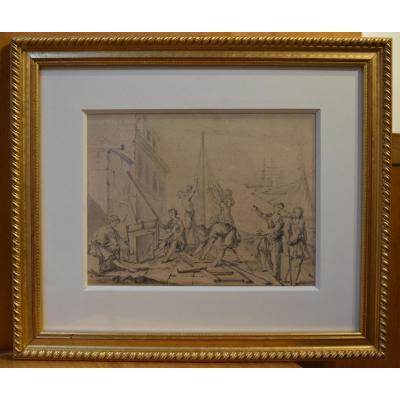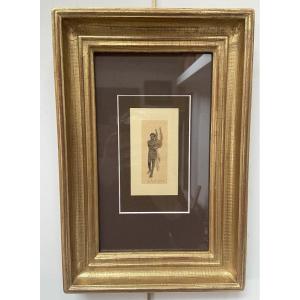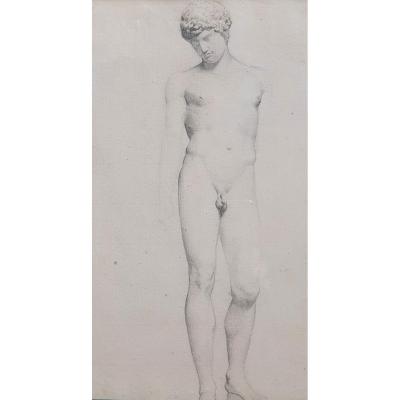A Tree above a thatched cottage
Signed lower left,
Monogrammed AE, probably a collector's mark as it appears on numerous drawings by Cicéri
30.5 x 23.5 cm
In good condition
framed : 46 x 39 cm
The bold framing is obviously a big part of the charm and interest of this drawing.
Cicéri adopts an almost photographic zoom effect upwards, using the roof of the thatched cottage on the right as a reference point.
There is a real modernity in this effect, and the composition of the drawing is remarkably careful.
Eugène Cicéri spent his formative years in an extended family of painters. His father, Pierre Luc Charles Cicéri (1782-1868), painted grand decorative murals and stage sets, and served as the designer of official ceremonies following the Restoration of Louis XVIII in 1814. Young Cicéri learned the basics of his craft from his father, and subsequently from his great-uncle Jean-Baptiste Isabey (1767-1855) who enjoyed extensive patronage under Napoleon as well as the royalist rulers of the 1820s and 1830s. Isabey’s son, also named Eugène, was only ten years older than his nephew Cicéri, and proved to be a lifelong artistic influence and friend.
He turned his attention to the landscape painting that his uncle, Eugène Isabey, was exploring. During this period, Isabey and Cicéri shared living quarters in the Parisian Quartier Pigalle where they were both influenced by their neighbors Théodore Rousseau, Jules Dupré, Narcisse Diaz, Johan Barthold Jongkind, and Jean-François Millet. Cicéri’s landscape painting, which became the basis for the rest of his career, reflected the concerns typical of these innovative artists: preservation of France’s rural landscapes; awareness of the sanctity of labor; and the encroachment of industrialization on a once bucolic environment. Not surprisingly, he made his Salon debut in 1851 at the exhibition now recognized for admitting the previously unwelcome Realist and Barbizon artists. The following year Cicéri won a third class medal for his riverscape entitled Vue Prise au bord du Loing. He continued to exhibit paintings at the annual Salons throughout the 1850s, switching to lithographs from the 1865 to 1882.
Cicéri’s landscape painting evolved in concert with emerging modernist developments of the Second Empire and the Third Republic. Travels to North Africa produced exotic images such as Oriental Market from 1869 or River Bank in Turkey in 1877, and a set of twenty-five color lithographs for Marius Fontane’s 1869 book, Voyage pittoresque à travers l’isthme de Suez, (Paris, P. Dupont). However, the primary focus of Cicéri’s work remained the landscape of France, particularly the region surrounding Paris and the countryside of Normandy.
By the 1870s, his color palette had brightened and his subject matter became increasingly concentrated on the formal and tonal relationships between sky, water and earth. Traces of the Barbizon aesthetic remain in the images of working men and women who fish and wash clothes and drive carriages, but attention to atmospheric effects and colored light suggests the growing influence of Impressionism; and like his uncle Isabey, Cicéri created skies that were vast and full of movement. Still painting at age 77, Cicéri died at the village of Marlotte near Fontainebleau on April 22, 1890.
His works are on display in public collections throughout the Europe and the United States, including the Louvre, the National Gallery in Berlin, the Getty Museum in Los Angeles and the French national museums at Châlons-sur-Marne, Chartres, Le Havre, Limoges, Mulhouse, Perpignan, and Troyes.


















































 Le Magazine de PROANTIC
Le Magazine de PROANTIC TRÉSORS Magazine
TRÉSORS Magazine Rivista Artiquariato
Rivista Artiquariato